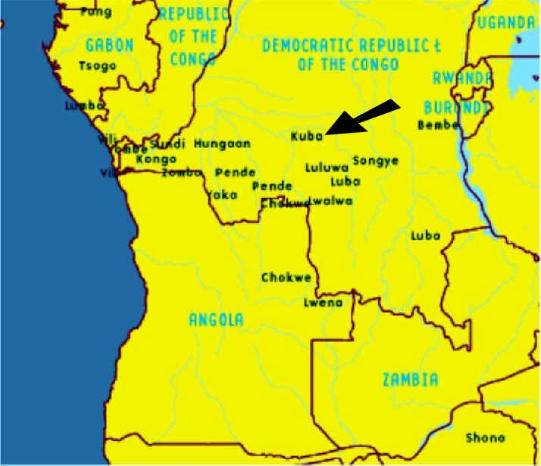
| KUBA Palm wine cups |
One of the important art forms identified with competition between titled court members among the Kuba are the carved palm-wine drinking cups. With half of all Bushoong men holding titles in the 1880s, competition for influence was sometimes fierce, and found expression in the elaboration of these essentially commonplace household objects into works of extraordinary beauty. Because Kuba individuals of high status signaled their largesse by distributing great quantities of palm wine to their friends and affiliates to attract a following, the complexity of such art came under public scrutiny. If, as the myths maintain, the inebriation caused by drinking palm wine led eventually to the formation of the royal line, drinking thus provided the social setting in which office holders were able to play out through art the precariousness of their own positions within this heatedly contested milieu. There are reports – not confirmed – that these cups might have been used in the poison ordeal. Among the Kuba, as among other African tribes, death was never attributed to natural causes, but to malevolent spirits or to witchcraft. The person suspected of using witchcraft was required to drink poison from such a cup. If he vomited up the drink, he was declared innocent. On the other hand, his death proclaimed his guilt and constituted his punishment. |
| Kuba cup 6 3/4 in x 4 ¼ in Provenance: Ex E. Lewandowski Collection |
| Other examples for reference purposes |

| Cup: Head with Headdress, 19th–20th century Democratic Republic of Congo; Kuba peoples Wood; H. 9 5/32 in. (23.26 cm) The Michael C. Rockefeller Memorial Collection, Purchase, Nelson A. Rockefeller Gift, 1967 (1978.412.541) Metropolitan Museum of Art Founded in the early seventeenth century in what is today south- central Democratic Republic of Congo, the Kuba kingdom was a wealthy state with an elaborate, merit-based system of courtly titles. Because positions of power within the Kuba court were awarded rather than inherited, members of the aristocracy went to great lengths to distinguish themselves from their peers. Drawing upon the skill and talent of local artisans, they commissioned elegant personal accessories that displayed their prosperity, personal achievements, and upward mobility. One way in which Kuba titleholders displayed their wealth and generosity was through the distribution of large quantities of palm wine to their friends and associates. At the court, drinking vessels were a vital accessory of great symbolic value. This ornately carved wooden cup combines human and animal forms to communicate ideals of refinement and power. Its elegant facial features are well formed and symmetrically arranged, while the mouth is small and closed, reflecting the belief that careful thought should always precede speech. The cup also depicts the Kuba aesthetic practice of shaving the hairline to frame and offset the forehead, considered the seat of wisdom and insight, and draw attention to the raised cicatrizes on the temples, another sign of cultural refinement. Large, curving horns are juxtaposed with these anthropomorphic elements. They evoke the ram, a dominant, aggressive animal that does not tolerate rivals. In the competitive atmosphere of Kuba political life, a man who embodied the dual qualities of cultivation and ambition could expect to attain impressive titles and awards. |

| Kuba cup D. R. Congo, late 19th-early 20th century Wood, copper, porcelain Height 9 1/4 inches Gift of William E. and Bertha L. Teel 1994.423 Formerly in the collection of Walschaert, Brussels. Acquired in 1992 Bibliography: Cornet 1982 Titles and status in the elaborate Kuba court structure were signified by prestige objects of handsome form and intricate detail, such as this vessel used for drinking palm wine. The head shown on the cup bears delicate geometric bands and a hatched coiffure, the small face is enhanced by a copper strip and sweeping coiffure edges identified with the Ngeende sub-style. Such cups were often carved to order by specialized artists. Boston Museum of Fine Arts |
| Kuba (Dem. Rep. of Congo). A palm-wine cup, nineteenth-twentieth century. Height 7-1/2" (19 cm). Werner Forman Archive, London. Visual puns are a prominent feature of many such cups. Here a human head serves as a vessel. In other cases, an image of an arm or hand is added to the handle, or the vessel itself takes the shape of a stomach. |
| Kuba (Dem. Rep. of Congo). A palm-wine cup in the shape of a drum, nineteenth century. Wood, height 7-1/4" (18.5 cm). Museum fur Volkerkunde, Berlin. The royal drum depicted in this palm wine cup represents a type known as bukit. A similar drum appears on the ndop sculpture of King Kot a-Mbul, the warrior king who ruled at the end of the eighteenth century. |

| Sotheby's Property from the Collection of Estelle Abrams A FINE AND RARE KUBA CUP LOCATION ESTIMATE AUCTION DATE New York 20,000—30,000 USD Session 1 15 May 03 10:15 AM Lot Sold. Hammer Price with Buyer's Premium: 24,000 USD height 7 3/8in. 18.7cm the hollowed vessel in the form of a seated figure, with large wedge-shaped feet and delicately carved hands held under the chin with elbows resting on bent knees, the muscular torso with a thick neck supporting a large head with sensitively carved facial features including a straight mouth, small nose and large almond-shaped eyes framed by dotted scarification, and wearing a close-cropped coiffure with incised cross-hatch motif, a rimmed opening at the crown; medium brown surface. Provenance: Acquired from Jacques Hautelet, Brussels Published: Robbins and Nooter (1989: 429, figure 1098) Kuba sensitivity to detail, design and texture is evident in the carving treatment of the highly treasured ceremonial palm wine cups. The cups were used by high-ranking individuals for palm wine-drinking rituals. See Robbins and Nooter (ibid) for related cups. |
| Return to the African cups page |








